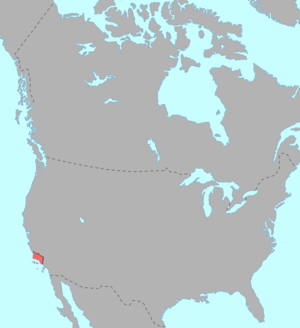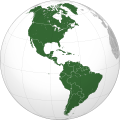- Chumashan languages
-
Chumash S.hamala Spoken in southern coastal California Extinct since the 1960s Language family ChumashLanguage codes ISO 639-3 variously:
boi – Barbareño
crz – Cruzeño
inz – Ineseño
obi – Obispeño
puy – Purisimeño
veo – Ventureño Pre-contact distribution of Chumashan languages
Pre-contact distribution of Chumashan languagesChumashan is a family of languages that were spoken on the southern California coast by Native American Chumash people.
From the Coastal plains and valleys of San Luis Obispo to Malibu), neighboring inland and Transverse Ranges valleys and canyons east to bordering the San Joaquin Valley; and on three adjacent Channel Islands: (San Miguel, Santa Rosa, and Santa Cruz).[1]
All of the Chumashan languages are now extinct, although they are well documented in the unpublished fieldnotes of linguist John Peabody Harrington. Especially well documented are the Barbareño, Ineseño, and Ventureño dialects. The last first-language speaker of a Chumashan language was Barbareño speaker Mary Yee, who died in 1965.
Contents
Family division
Languages
Chumashan consists of 6 languages.
I. Northern Chumash
- 1. Obispeño (also known as Northern Chumash) (†)
II. Southern Chumash
- a. Island Chumash
- 2. Island Chumash (also known as Ysleño, Isleño, Cruzeño) (†)
- b. Central Chumash
Obispeño was the most divergent Chumashan language. Ineseño and Barbareño may have been dialects of the same language. There is very little documentation of Purisimeño. There were several different subdialects of Ventureño. Island Chumash had different subdialects spoken on Santa Cruz Island and Santa Rosa Island, but all its speakers were relocated to the mainland in the early 19th century. John Peabody Harrington conducted fieldwork on all the above Chumashan languages, but obtained the least data on Island Chumash, Purisimeño, and Obispeño.
Post-contact
The languages are named after the local Franciscan Spanish missions in California where Chumashan speakers were relocated and aggregated between the 1770s and 1830s:
- Obispeño — Mission San Luis Obispo de Tolosa
- Purisimeño — Mission La Purísima Concepción
- Ineseño — Mission Santa Inés
- Barbareño — Mission Santa Barbara
- Ventureño — Mission San Buenaventura
Genetic relations
Roland Dixon and Alfred L. Kroeber suggested that the Chumashan languages might be related to the neighboring Salinan in a Iskoman grouping.[2] Edward Sapir accepted this speculation and included Iskoman in his classification of Hokan.[3] More recently it has been noted that Salinan and Chumashan shared only one word, which the Chumashan languages probably borrowed from Salinan (the word meant 'white clam shell' and was used as currency).[4] As a result, the inclusion of Chumashan into Hokan is now disfavored by most specialists, and the consensus is that Chumashan has no identified linguistic relatives.[5]
Characteristics
The Chumashan languages are well-known for their consonant harmony (regressive sibilant harmony). Mithun presents a scholarly synopsis of Chumashan linguistic structures.[6]
See also
- Chumash people
- Rock art of the Chumash people
- Burro Flats Painted Cave
- Population of Native California
- Native Americans in the United States
Notes
Bibliography
- Applegate, Richard. (1972). Ineseño Chumash Grammar. (Doctoral dissertation, University of California, Berkeley).
- Campbell, Lyle. (1997). American Indian languages: The historical linguistics of Native America. New York: Oxford University Press. ISBN 0-19-509427-1.
- Dixon, Roland R.; & Kroeber, Alfred L. (1913). New Linguistic Families in California. American Anthropologist 15:647-655.
- Goddard, Ives (Ed.). (1996). Languages. Handbook of North American Indians (W. C. Sturtevant, General Ed.) (Vol. 17). Washington, D. C.: Smithsonian Institution. ISBN 0-16-048774-9.
- Klar, Kathryn. (1977). Topics in historical Chumash grammar. (Doctoral dissertation, University of California, Berkeley).
- Mithun, Marianne. (1999). The languages of Native North America. Cambridge: Cambridge University Press. ISBN 0-521-23228-7 (hbk); ISBN 0-521-29875-X.
- Grant, Campbell. (1978). Chumash:Introduction. In California Handbook of North American Indians (William C. Sturtevant, General Ed.) Vol. 8 (Robert F. Heizer, Volume Ed.). Washington, D. C.: Smithsonian Institution.
- Sapir, Edward. (1917). The Position of Yana in the Hokan Stock. University of California Publications in American Archaeology and ethnology 13:1–34. Berkeley: University of California.
- Wash, Suzanne. (1995). Productive Reduplication in Barbareño Chumash. (Master's thesis, University of California, Santa Barbara; 210 + x pp.)
- Wash, Suzanne. (2001). Adverbial Clauses in Barbareño Chumash Narrative Discourse. (Doctoral dissertation, University of California, Santa Barbara; 569 + xxii pp.)
 Indigenous peoples of the Americas
Indigenous peoples of the AmericasHistory 
European
colonizationBy country North AmericaGreenland · Canada · United States · Jamaica · Mexico · Central America · El Salvador · West Indies · PanamaSouth AmericaRelated topics Indigenous American studies · Indigenous languages · Indigenous Movements · Indigenous art · Artists · Writers Pre-Columbian North America
Pre-Columbian North AmericaArchaeological cultures North American pre-Columbian chronology – Adena – Alachua – Ancient Pueblo (Anasazi) – Baytown – Belle Glade – Buttermilk Creek Complex – Caborn-Welborn – Calf Creek – Caloosahatchee – Clovis – Coles Creek – Deptford – Folsom – Fort Ancient – Fort Walton – Fremont – Glades – Glacial Kame – Hopewell (List of Hopewell sites) – Hohokam – Leon-Jefferson – Mississippian (List of Mississippian sites) – Mogollon – Monongahela – Old Cordilleran – Oneota – Paleo-Arctic – Paleo-Indians – Patayan – Plano – Plaquemine – Poverty Point – Prehistoric Southwest – Red Ocher – Santa Rosa-Swift Creek – St. Johns – Steed-Kisker – Tchefuncte – Tocobaga – Troyville
Archaeological sites Angel Mounds – Bandelier National Monument – The Bluff Point Stoneworks – Cahokia – Chaco Canyon – Casa Grande – Coso Rock Art District – Eaker – Effigy Mounds National Monument – Etowah Indian Mounds – Eva – Folsom Site – Fort Ancient – Fort Center – Gila Cliff Dwellings National Monument – Holly Bluff Site – Hopewell Culture National Historical Park – Kincaid Mounds – Kolomoki – Manitou Cliff Dwellings – Marksville – Meadowcroft Rockshelter – Mesa Verde – Moorehead Circle – Moundville – Mummy Cave – Nodena Site – Ocmulgee National Monument – Old Stone Fort – Parkin Park – Pinson Mounds – Portsmouth Earthworks – Poverty Point – Pueblo Bonito – Rock Eagle – Rock Hawk – Salmon Ruins – Serpent Mound – Spiro Mounds – SunWatch – Taos Pueblo – Toltec Mounds – Town Creek Indian Mound – WintervilleMiscellaneous Ballgame – Black drink – Buhl woman – Calumet – Chunkey – Clovis point – Container Revolution – Eastern Agricultural Complex – Eden point – Effigy mound – Falcon dancer – Folsom point – Green Corn Ceremony – Horned Serpent – Kennewick man – Kiva – Metallurgy – Mi'kmaq hieroglyphic writing – Medicine wheel – Mound builders – N.A.G.P.R.A. – Norse colonization of the Americas – Piasa – Pueblo dwellings – Southeastern Ceremonial Complex – Three Sisters agriculture – Thunderbird – Underwater panther
External links
- Obispeño language overview at the Survey of California and Other Indian Languages
Categories:- Chumash people
- Chumashan languages
- Native American history
- Native American history of California
- Indigenous languages of California
Wikimedia Foundation. 2010.

